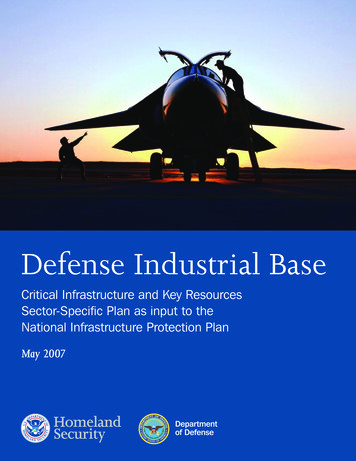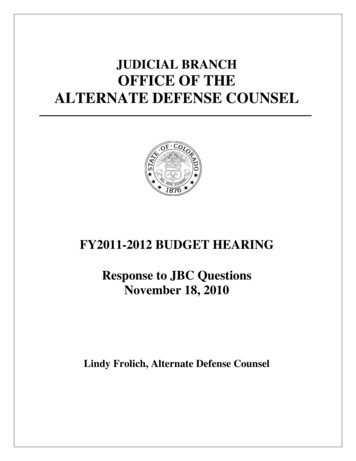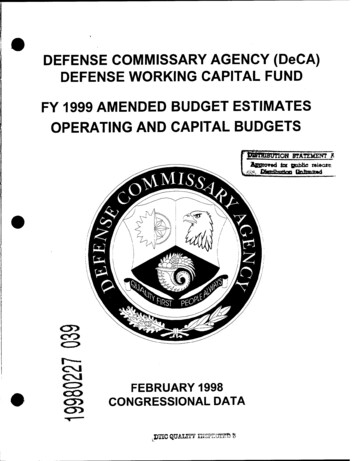
Transcription
Defense Industrial BaseCritical Infrastructure and Key ResourcesSector-Specific Plan as input to theNational Infrastructure Protection PlanMay 2007
PrefaceIn June 2006, the Secretary of Homeland Security, supported by the Secretary of Defense and all otherFederal cabinet Heads, published the National Infrastructure Protection Plan(NIPP) as called for inthe National Strategy for Homeland Security and Homeland Security Presidential Directive-7 CriticalInfrastructure Identification, Prioritization, and Protection, December 17, 2003 (HSPD-7). The NIPP provides theoverarching approach for integrating the Nation’s many Critical Infrastructure and Key Resources protection initiatives into a single national effort.Recognizing that each Critical Infrastructure sector possesses its own unique characteristics, operatingmodels, and risk landscapes, HSPD-7 designates Federal Government Sector-Specific Agencies (SSA) foreach sector. The Department of Defense (DoD) is designated the SSA for the Defense Industrial Base (DIB).The Department of Defense is pleased to publish this Sector-Specific Plan for the DIB. This Plan is aproduct of extensive collaboration among DoD, its interagency partners, and representatives of theprivate sector. Our national and international private sector partners make up the majority of DIBowners/operators, and range from small proprietors to Fortune 500 corporations employing tens ofthousands of people. It is only through their continued voluntary cooperation that the important workof protecting the defense industrial base can be achieved.This plan is a living document. As the national security environment continues to evolve, so must ourplans. To this end, the DIB partners have committed to periodic Plan reviews and revisions ensuringthe highest standard of preparedness and readiness of the DIB Sector. The Defense Industrial Base is anunmatched element of National Power that differentiates the United States from all potential opponents.Protection of the DIB is paramount to maintain that competitive advantage in executing National Strategy.Peter F. VergaActing Assistant Secretary of Defense forHomeland Defense and Americas’ Security AffairsPrefacei
iiDefense Industrial Base Sector Government Coordinating Council Letter of Approval
Defense Industrial Base Sector Government Coordinating Council Letter of Approvaliii
ivDefense Industrial Base Sector Coordinating Council Letter of Acknowledgement
Table of ContentsExecutive Summary11. Sector Profile and Goals12. Identify Assets, Systems, Networks, and Functions13. Assess Risks14. Prioritize Infrastructure25. Develop and Implement Protective Programs26. Measure Progress27. CI/KR Protection Research and Development (R&D)28. Managing and Coordinating SSA Responsibilities2Introduction1. Sector Profile and Goals351.1 Sector Profile51.2 Security Partners61.2.1 Within Department of Defense61.2.2 Private Sector Owner/Operators and Organizations71.2.3 Other Federal Departments and Agencies71.2.4 State and Local Agencies91.2.5 International Organizations and Foreign Countries91.3 Sector Security Goals101.3.1 Elements and Characteristics of Sector Security Goals101.3.2 Process to Establish Sector Security Goals111.4 Value Proposition2. Identify Assets, Systems, Networks, and Functions11132.1 Defining Information Parameters132.2 Collecting Infrastructure Information142.3 Verifying Infrastructure Information152.4 Updating Infrastructure Information153. Assess Risk173.1 Use of Risk Assessment in the Sector173.2 Screening Infrastructure18Table of Contentsv
3.2.1 Mission-Oriented Screening183.2.2 Human, Economic, and Public Confidence Impacts183.3 Assessing Consequences193.4 Assessing Vulnerabilities193.5 Assessing Threats204. Prioritize Infrastructure214.1 Asset Prioritization Model214.2 Asset Prioritization Factors214.3 Asset Prioritization Review and Update Process225. Implement Protective Programs235.1 Overview of Sector Protective Program235.2 Determining Protective Program Needs245.3 Protective Program Implementation245.4 Protective Program Performance266. Measure Progress6.1 Critical Infrastructure Performance Measurement27276.1.1 Developing Sector-Specific Metrics286.1.2 Information Collection and Verification306.1.3 Reporting316.2 Implementation Actions316.3 Challenges and Continuous Improvement347. CI/KR Protection Research and Development357.1 Overview of Sector R&D357.2 Sector R&D Requirements367.3 Sector R&D Plan377.4 R&D Management Process388. Managing and Coordinating SSA Responsibilities398.1 Program Management Approach398.2 Processes and Responsibilities398.2.1 SSP Maintenance and Update398.2.2 Annual Reporting408.2.3 Resources and Budgets408.2.4 Training and Education408.3 Implementing the Sector Partnership Model418.3.1 NIPP Coordination Councils418.3.2 State, Local, and Tribal Government Entities43viDefense Industrial Base Sector-Specific Plan
8.3.3 International Security Partners438.4 Information Sharing and Reporting.44Appendix 1: List of Acronyms and AbbreviationsAppendix 2: References4749Statutes49National Strategies49Homeland Security Presidential Directives49Executive Plans and Orders49Department of Defense Directives and Strategies50Guidance and Regulation50Charters50List of TablesTable 1-1.DIB Segments and Subsegments5Table 1-2.Defense Industrial Base Commodities6Table 4-1.Prioritization Factors22Table 6-1.Core NIPP Implementation Metrics27Table 6-2.DIB Sector-Specific Goals and Metrics29Table 6-3.DIB Sector Implementation Actions32Table of Contentsvii
Executive SummaryThis Defense Industrial Base (DIB) Sector-Specific Plan (SSP), developed in collaboration with industry and government security partners, provides sector-level critical infrastructure and key resources (CI/KR) protection guidance. The DIB SSP outlinesthe Department of Defense (DoD) approach to executing Sector-Specific Agency (SSA) responsibilities assigned by HomelandSecurity Presidential Directive 7 (HSPD-7), Critical Infrastructure Identification, Prioritization, and Protection, December 17,2003, and follows the 2006 CI/KR Protection SSP Guidance established by the Department of Homeland Security (DHS). Itcomplements other DoD critical infrastructure policy.To ensure effective integration with the National Infrastructure Protection Plan (NIPP) Base Plan, the following sections are included:1. Sector Profile and GoalsThis section describes the DIB Sector and the taxonomy used to classify the DIB products and services. It identifies securitypartners in government and the private sector, and discusses their roles and responsibilities. The section includes the DIBSector’s goals and desired long-term security posture and provides a value proposition for security partners.2. Identify Assets, Systems, Networks, and FunctionsThis section discusses the information parameters, requirements, and methodologies that DoD and the DIB owners/operatorsuse to identify their assets, systems, networks, and critical functionality. The section focuses on the process to identify thoseassets, systems, networks, and functions that, if damaged, would result in unacceptable consequences to the DoD mission,national economic security, public health and safety, or public confidence.3. Assess RisksThis section complements the NIPP risk management framework, the basis of the national protection strategy, and includes adescription of the DIB risk assessment process. By focusing on risk, protection efforts and resources are applied to achieve thegreatest benefit. Risk assessments include consequence, vulnerability, and threat analysis. DoD is evaluating the existing criteria foridentifying critical assets to determine if it adequately assesses the impacts to the DoD mission, national economic security, publichealth and safety, and public confidence. Modifications to the assessment criteria will be developed and implemented if required.Executive Summary1
4. Prioritize InfrastructureThis section describes the process for performing a risk-based prioritization of DIB assets, systems, networks, and functionsincluded in the sector. The key element is an Asset Prioritization Model (APM) that includes 16 distinct factors broadly classifiedinto Mission (5), Threat (5), Economic (4), and Other (2) categories.5. Develop and Implement Protective ProgramsThe emphasis of this section is on discussion of a layered “defense in depth” approach to infrastructure protection. Theapproach relies on collaborative implementation of self-assessment and self-protection in the private sector, dependence onlocal emergency responders for the next level of protection, and direct action by the SSA in the most extreme circumstancesor when the most critical assets are involved. Plans developed under this paradigm help manage risks by deterring threats,mitigating vulnerabilities, and/or minimizing the associated consequences.6. Measure ProgressThis section describes how the DIB Sector measures risk management success. It addresses the development of goals and associated metrics to continuously improve the DIB Sector’s protection and risk mitigation efforts. This section will be refined as thesector’s risk management process matures. The national goals and metrics will be integrated into this section when provided bythe DHS.7. CI/KR Protection Research and Development (R&D)CI/KR Protection R&D specific to the DIB Sector is in its earliest stages. As the DIB risk management process matures, DoD willcollect unmet requirements for meeting security goals. DoD will partner with the DHS to leverage existing programs, advocate for national solutions, or initiate sector-specific R&D efforts as appropriate. This section discusses the current state of theconcepts, ideas, and mechanisms available, and projects a collaborative methodology for further development.8. Managing and Coordinating SSA ResponsibilitiesPer HSPD-7, DoD is the SSA responsible for collaboration with the DIB security partners, conducting or facilitating DIB vulnerability assessments, and encouraging risk management strategies to protect and mitigate the effects of attacks. This sectiondescribes the management process developed by the SSA to support those responsibilities assigned by HSPD-7.This plan, developed as an annex to the NIPP Base Plan, describes the initial efforts to enhance the protection of the DIB. TheSSP will be reviewed annually to reflect improvements and to address changes to the threat, technology, and sector profile.Revisions will be coordinated with DIB sector security partners.2Defense Industrial Base Sector-Specific Plan
IntroductionThe Department of Defense (DoD) is executing the Strategy for Homeland Defense and Civil Support that builds upon the concept of an active, layered defense called for in the National Defense Strategy. This active, layered defense is global, seamlesslyintegrating U.S. capabilities in the forward regions of the world, the global commons of space and cyber space, the geographicapproaches to U.S. Territory, and within the United States itself. It is a defense in depth. Near the actual and figurative coreof this defense lie the critical infrastructure and key resources (CI/KR) of the United States essential to the Nation’s security,economic vitality, and way of life. CI/KR includes the assets, systems, networks, and functions that provide vital services to theNation. Terrorist attacks on CI/KR and other manmade or natural disasters could disrupt the functioning of government andbusiness alike, and produce cascading effects far beyond the affected infrastructure sector and physical location of the incident.Direct attacks could result in large-scale human casualties, property destruction, and economic damage, and could profoundlydamage national prestige, morale, and confidence. Terrorist attacks that use components of the Nation’s CI/KR as weapons ofmass destruction could have even more devastating physical, psychological, and economic consequences.Homeland Security Presidential Directive 7 (HSPD-7) assigns two distinct tasks to DoD. First, like all Federal departments andagencies, DoD is responsible for identifying, prioritizing, and protecting the infrastructure essential to its ongoing ability toexecute its mission. Second, DoD is designated as the Sector-Specific Agency (SSA) charged with leading a collaborative, coordinated effort to identify, assess, and improve risk management of critical infrastructure within the Defense Industrial Base (DIB).Execution of these responsibilities fits very well within the framework of “Lead,” “Support,” and “Enable” construct articulatedin the Strategy for Homeland Defense and Civil Support. In executing the HSPD-7 responsibility for its own assets, DoD isclearly in the Lead, and has published a directive covering the Defense Critical Infrastructure Program (DCIP), which includesDoD-owned elements of the DIB. Therefore, the efforts to identify, assess, and improve risk management of those DoD-ownedassets are not addressed under this plan. Instead, this plan describes the collaborative environment where DoD can support andenable the efforts of other critical DIB asset owners/operators.Building on the requirements of HSPD-7, the Secretary of Homeland Security, in coordination with the Secretary of Defenseand the heads of all other Cabinet-level agencies, published the National Infrastructure Protection Plan (NIPP). The NIPPprovides the framework for the unprecedented cooperation that is essential to develop, implement, and maintain a coordinatednational effort that brings together government at all levels, the private sector, and international organizations and allies. Anessential element of this framework is the complementary Sector-Specific Plans (SSP) required of each SSA. This document represents DoD’s effort, as the SSA for the DIB, to prepare a plan that describes a vision and methodology to identify critical assets,assess risk, and improve risk management within the sector. DoD will lead industry partners in the few critical circumstanceswhere it is appropriate, support civil authorities at the State and local levels who are the firstresponders to any incident at a DIBsite, and enable all of our security partners to improve their own security preparedness.Introduction3
This SSP supports the planning assumptions outlined in the NIPP and identifies DIB sector-specific planning assumptions relevant to protecting the sector’s critical infrastructure. The remainder of this SSP is structured around each of the steps outlinedin the risk management framework: Set Security Goals: Define specific outcomes, conditions, end points, or performance targets that collectively constitute aneffective protective posture. Identify Infrastructures: Develop an inventory of the assets, systems, and networks, and the critical functions they provide,including infrastructure located outside the United States, that make up the Nation’s critical infrastructure, and collect information pertinent to risk management. Assess Risks: Determine risk by combining potential direct and indirect consequences of a terrorist attack or other hazard(including dependencies and interdependencies associated with each identified asset, system, or network), known vulnerabilities to various potential hazards, and general or specific threat information. Prioritize: Aggregate and analyze assessment results to determine asset, system, and network criticality, and present a comprehensive picture of national infrastructure risk to establish protection priorities and provide the basis for protection planningand the informed allocation of resources. Implement Protective Programs: Select appropriate protective actions or programs to reduce the risk identified and securethe resources needed to address priorities. Measure Effectiveness: Use metrics and other evaluation procedures at the national and sector levels to measure progress andassess the effectiveness of the national infrastructure protection program.The DIB is the DoD, U.S. Government, and private sector worldwide industrial complex with capabilities to perform researchand develop, produce, deliver, and maintain military weapon systems, subsystems, components, or parts to meet militaryrequirements necessary to fulfill the National Military Strategy (NMS). The DIB is comprised of hundreds of thousands ofindustrial sites. The preponderance of the DIB is privately owned and comprised of businesses of all sizes.To execute the SSA responsibilities for the DIB successfully, DoD must initiate and maintain activities to build trust with theDIB critical asset owner/operators. This will support two-way information sharing and maintain meaningful relationships andfrequent dialogue across the diverse array of DIB partners.Private sector participation in executing the NIPP is voluntary. Many large defense industry firms place a great deal of emphasison protecting their physical, human, and cyber assets. On the other hand, many of the medium and small size businesses arechallenged to make the capital investments required to perform vulnerability assessments and build resiliency into their operational capabilities. This SSP lays out how DoD plans to work with DIB security partners to meet the intent of HSPD-7. Takentogether, our efforts will build a safer, more secure, and resilient DIB by understanding and sharing information, buildingsecurity partnerships, implementing long-term risk management programs, and maximizing efficient use of resources.4Defense Industrial Base Sector-Specific Plan
1. Sector Profile and Goals1.1 Sector ProfileThe DIB is DoD, the U.S. Government, and the private sector worldwide industrial complex with capabilities to performresearch and development (R&D), design, produce, deliver, and maintain military weapon systems, subsystems, components,or parts to meet military requirements. The DIB includes hundreds of thousands of domestic and foreign entities and theirsubcontractors performing work for DoD and other Federal departments and agencies. Defense-related products and servicesprovided by the DIB equip, inform, mobilize, deploy, and sustain forces conducting military operations worldwide.The DIB does not include commercial infrastructure that provides, for example, power, communications, transportation, andother utilities that DoD warfighters and support organizations use to meet their respective operational needs. Those commercial infrastructures are addressed by the other SSAs and through dependency analysis.Because only a small fraction of DIB facilities are DoD-owned, the efforts described in this document focus on DoD andgovernment actions to support private owner/operator efforts at DIB facilities determined to be critical to national security. TheAssistant Secretary of Defense for Homeland Defense & Americas’ Security Affairs (ASD(HD&ASA)), working in coordinationwith all pertinent elements of DoD, will ensure the identification of critical DIB assets, facilitate risk assessment, and encourageremediation of privately owned critical-asset vulnerabilities. Roles and responsibilities within DoD for the DIB are discussed inmore detail in later sections of this document.Sector Profile and Goals5
Table 1-2: Defense Industrial Base CommoditiesMechanical Diesel EnginesRocket EnginesTurbine EnginesAircraft Transmission Automotive TransmissionLanding GearBearingsPumps & Compressors Nuclear ComponentsHydraulics CompositesPrecious Metals Aircraft Circuit BreakersSwitch Gear Traveling Wave TubesCircuit BoardsSoftwareStructural ForgingsCastings Depleted Uranium ArmorCeramic ArmorElectrical Electrical MotorsBatteries Thermal Auxiliary Power UnitsLow Smoke Wire & CableElectronics OpticsGuidance/ControlCommunication DigitizationGPS ReceiverSemiconductorsThe DIB is subdivided into Segments, Sub-segments, and Commodities that produce weapon system platforms, components, andexpendables. This taxonomy is used throughout DoD to classify the contributions of particular DIB assets, as well as to analyzethe criticality using subject matter experts from each of the areas. This categorization is most applicable to the analysis of impacton DoD mission accomplishment, but it may also contribute to the economic, life, and health consequence areas. As discussed inlater sections, security partners throughout the DIB might organize analysis and response efforts around this taxonomy.1.2 Security Partners1.2.1 Within Department of DefenseHSPD-7 assigns the responsibility for collaborating with relevant partners, encouraging or conducting vulnerability assessments, and encouraging risk management practices for DIB CI/KR to the Secretary of Defense (SECDEF). Effectively executingthese responsibilities requires a complex communications network of organizations with diverse roles and missions.Assistant Secretary of Defense for Homeland Defense & Americas’ Security Affairs (ASD(HD&ASA))ASD(HD&ASA) is responsible for coordinating the protection of the department’s critical infrastructure and for DoD participation in the Critical Infrastructure Protection (CIP) programs at the national, State, and local-levels. Also, commensurate withresponsibilities assigned to DoD by HSPD-7, ASD(HD&ASA) serves SECDEF as the lead SSA official for the DIB.ASD(HD&ASA) assigned responsibility for the DCIP, including DIB SSA responsibilities, to the Director for CIP under theDeputy Assistant Secretary of Defense for Force Planning and Employment. The Director for CIP provides policy, programoversight, integration, and coordination of CIP activities through the DCIP, and leverages related DoD and national programssupporting CIP.Undersecretary of Defense for Acquisition, Technology, and Logistics (USD(AT&L))USD(AT&L) is the Principal Staff Assistant and advisor to SECDEF for all matters relating to the Defense Acquisition System.In addition, USD(AT&L) is the lead for developing industrial and technology base assessments of, and establishing policies tomaintain, the capability of the DIB to meet DoD needs—a responsibility that overlaps heavily with DIB SSA responsibilities.Because of this overlap, USD(AT&L) has a primary role and contributes to the execution of DIB SSA responsibilities.6Defense Industrial Base Sector-Specific Plan
Defense Contract Management Agency (DCMA)ASD(HD&ASA) has assigned DCMA as the operational lead for executing SSA responsibilities because of its established workingrelationship with DIB owners/operators. DCMA responsibilities are to plan and coordinate with all DoD Components and privatesector partners that own or operate elements of the DIB to identify, analyze, and assess DIB critical assets and related impacts.Assistant Secretary of Defense for Networks and Information Integration (ASD(NII))ASD(NII) serves as the primary advisor to SECDEF for information assurance (IA), networks and network-centric policies andconcepts, and DoD enterprise-wide architectures and information technology (IT). ASD(NII) works in consultation and coordination with the Under Secretary of Defense (Intelligence) (USD(I)), ASD(HD&ASA), and USD(AT&L) on IA and cyber-relatedpolicies and issues.ASD(NII) is responsible for formulating and implementing enterprise-level defense strategies from the information, IT, and network-centric perspectives, including assuring the availability of the Global Information Grid (GIG). ASD(NII) must develop andmaintain the DoD IA Program and assorted policies, procedures, and standards, and perform the duties and fulfill the responsibilities associated with information security. While ASD(NII) is responsible within DoD for assuring the availability of the GIG,those responsibilities do not extend to the private sector portion of the DIB. There is no specific cyber asset characterized aspart of the DIB Sector. Individual DIB assets likely have cyber elements within them, but they are the responsibility of the assetowner/operator. Cyber security is part of the critical asset risk assessment process, and the expertise of ASD(NII) will be soughtfor development and distribution of best practices to be shared with all DIB security partners.Undersecretary of Defense (Intelligence) (USD(I))In accordance with DoD policy, USD(I) is the DoD Senior Security Official. Responsibilities include integration of risk-managedsecurity and protection policies and programs for personnel, physical, industrial, information, operations, chemical/biologicaland DoD special access program security as well as research and technology protection.Undersecretary of Defense (Personnel and Readiness) (USD(P&R))USD(P&R) is the principal advisor to SECDEF regarding oversight and measurement of readiness to ensure forces can executethe NMS. The staff of P&R is overseeing development and implementation of the Defense Readiness Reporting System. Whenfully implemented, the system will integrate information regarding the elements of the DIB. This integration will permit aclear assessment of the DIB’s ability, at any particular time, to deliver required assets to DoD to support mission execution.1.2.2 Private Sector Owner/Operators and OrganizationsDoD relies on private industry organizations to exchange information on DIB infrastructure. DoD partners with defense industry associations, such as the National Defense Industrial Association (NDIA), Aerospace Industries Association (AIA), NationalClassification Management Society (NCMS), American Society of Industrial Security (ASIS) International, and IndustrialSecurity Working Group (ISWG) to identify issues and potential solutions. These and other defense industry associations makeup the membership of the Sector Coordinating Council (SCC) described later in this document. Working with industry, DoDwill develop protocols for sharing and protecting information about critical DIB assets with sector security partners.1.2.3 Other Federal Departments and AgenciesDoD collaborates with representatives from the Department of Homeland Security (DHS), other SSAs, and appropriate supporting Federal departments and agencies to ensure that DIB SSP efforts are consistent with, and fully support, national CIP effortsand DoD national defense requirements.The supporting roles of other Federal departments and agencies for the DIB include:Sector Profile and Goals7
DHS, Office of Infrastructure Protection (OIP):– Oversee the consistent use of SSA plan guidance across Federal departments and agencies;– Collaborate with DoD to deter, prevent, and defeat physical and cyber incidents perpetrated against the DIB;– Collaborate with DoD to conduct or facilitate vulnerability assessments of the DIB;– Coordinate development of risk management strategies to protect against and mitigate the effects of attacks against the DIB; and– Collaborate with DoD to identify and establish additional DIB-coordinating mechanisms that identify, prioritize, andcoordinate protection of CI/KR; and facilitate sharing of information about physical and cyber threats, vulnerabilities,incidents, potential protective measures, and best practices. DHS, Office of Cyber Security and Telecommunications (CST), together with OIP, is responsible for deterring, preventing, and defeating cyber incidents across all CI/KR sectors. Federal Bureau of Investigation (FBI):– Maintain awareness of critical DIB assets;– Ensure that the respective critical DIB asset owner/operator receives at least one face-to-face contact annually with theassigned Special Agent in Charge;– Investigate reported suspicious activity and provide feedback to the reporting official; and– Respond to incidents as required by the asset owner/operator or by State and local law enforcement officials. Department of Energy (DOE): Through the National Nuclear Security Administration (NNSA), DOE works to enhancenational security through the military application of nuclear energy and by reducing the global threat from terrorism andweapons of mass destruction.NNSA has three goals regarding national security:– Nuclear Weapons Stewardship: Ensure that U.S. nuclear weapons continue to serve their essential deterrence role bymaintaining and enhancing the safety, security, and reliability of the U.S. nuclear weapons stockpile;– Nuclear Nonproliferation: Provide technical leadership to limit or prevent the spread of materials, technology, andexpertise relating to weapons of mass destruction; advance the technologies to detect the proliferation of weaponsof mass destruction worldwide; and eliminate or secure inventories of surplus materials and infrastructure usable fornuclear weapons; and– Naval Reactors: Provide the U.S. Navy with safe, militarily effective nuclear propulsion plants and ensure their continuedsafe and reliable operation. Department of Commerce (DOC): Through the Bureau of Industry and Security (BIS), DOC advances U.S. nationalsecurity, foreign policy, and economic objectives by ensuring an effective export control and treaty compliance system andpromoting continued U.S. strategic technology and DIB leadership. BIS administers the Defense Priorities and AllocationsSystem regulation (15 Code of Federal Regulations (CFR) Part 700) to require preferential acceptance and performance ofcontracts and orders for materials, services, and facilities needed to support approved national defense programs, including CIP and restoration. BIS also conducts primary research and analysis of critical technologies and industrial capabilitiesof key defense-related sectors using detailed surveys to provide essential financial and production data. These activities areauthorized under the authority of the Defense Production Act of 1950, as amended, and Executive Order 12656. DOC’sNational Telecommunications and Information Administration carries out the primary mission-essential function—to“achieve robust communications capability for the Industrial/Commercial Sector”—directly supporting national essentialfunctions and
cept of an active, layered defense called for in the National Defense Strategy. This active, layered defense is global, seamlessly integrating U.S. capabilities in the forward regions of the world, the global commons of space and cyber space, the geographic approaches to U.S. Territory, and within the United










